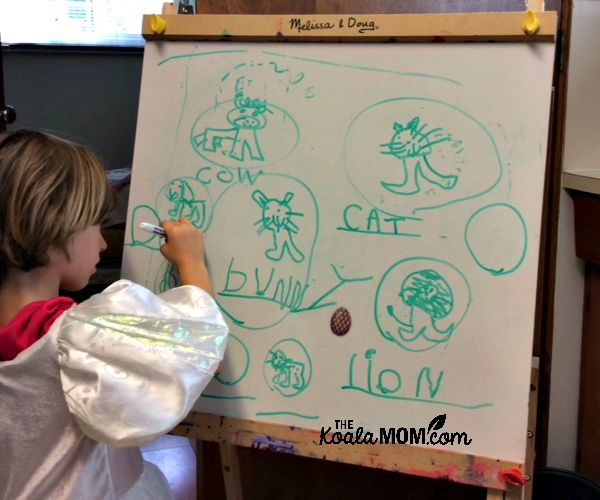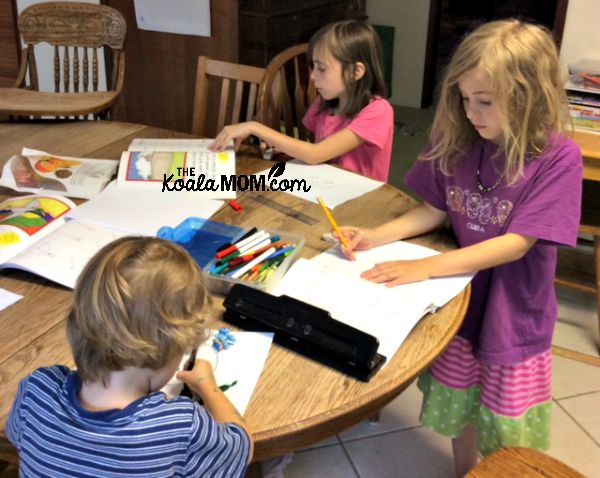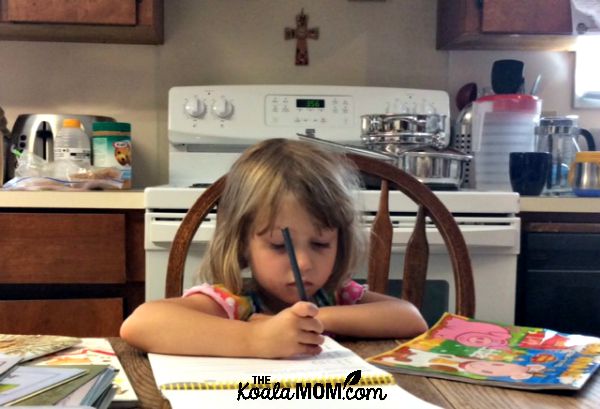TKM contributing writer Anna Eastland is currently homeschooling three children (with two more watching it all) in Grades 4, 2 and Kindergarten. Here, she shares some of the benefits she’s seen in having a multi-age classroom.
Sometimes when people think about homeschooling, they get overwhelmed by the idea of teaching children of multiple ages at the same time, and imagine it’s a multitasking nightmare. And sure, a toddler climbing on the table occasionally makes math with your Grade 2 student a little harder. But while there are challenges, I have found there also many benefits to a multi-age level learning environment.
1. Children like to share what they learn. It this especially exciting for them when they can play teacher and show their younger siblings how to spell a word or make a shape. My elementary students love to use our Melissa and Doug whiteboard/chalkboard (affiliate link) when teaching the preschoolers.
2. Teaching what you have learned reinforces your knowledge, and helps you understand it more deeply. It also builds confidence and care for others. In a classroom where everyone is the same age, there are less opportunities to do this.
3. According to educator and homeschool advocate Andrew Pudewa, founder of the Institute for Excellence in Writing, children strive to speak better and use more diverse vocabulary when with people of different ages, whether to teach the younger ones, or to impress the older ones. Alternatively, kids tend to slide to the lower common denominator when in a group of peers, and revert to slang and simple language, lest they stand out.
4. Homeschooling gives many opportunities for interesting family discussions, and allows younger children to participate at a level above their peers. You would be surprised at how well they listen and what insights they have. It also helps children to be understanding and supportive of each other’s contributions, realizing people are at different levels, rather than being overly competitive.
5. A multi-age classroom mimics real life, and teaches children how to respond and interact with people who are not their direct peers. Where else in life, except the school classroom, are people surrounded only by others of their own age? At work and in social situations, one encounters both older and younger people, and should know how to interact with them, rather than learning to ignore them if they are not “in the same class.” Homeschooled kids are often very confident about speaking to adults, as well as in caring for their younger siblings.
6. Younger siblings want to imitate their older siblings and do what they do. They learn so much by example. I just started Kindergarten with my third daughter about two weeks ago, but she has picked up so much already from her older sisters—counting to 100, the alphabet, how to write her letters and copy out words, how to make up a story for me to record in her book, many science concepts, etc—just from being around while the others were learning. Her little sister, not yet 4, is tracing her letters and tired of just colouring, and wants her own “learning books.”
7. Homeschooling offers the flexibly to teach children according to their interests and ability, rather than restricting them to material from a set grade. Certain topics can be covered much faster by kids who excel at them, or in more depth. Other things can be done more slowly, without excessive concern about keeping up with the others in their class. Each person is on their own schedule, doing their best.
When you look at the bigger picture of education, at what kind of people we are trying to help our children become, we can see there are many advantages to a multi-age classroom. Virtues like caring for others, being generous and understanding, helping others and cooperating with people of different ages and abilities are all fostered here. So are patience, initiative and independence, because you can’t always help everyone at the same time, so they need to learn how to study, even if briefly, on their own. More skills for the future!
So while learning in a family setting has its challenges (maybe more on that another post!), it definitely also had many benefits and is well worth a try. I hope you’ll love it as much as I do!
Anna Eastland is the mother of six children (with one in heaven). She blogs at Just East of Crazy Land about mothering, homeschooling and infant loss. She also wrote the title essay and several poems for the anthology Love Rebel: Reclaiming Motherhood.
This post contains an affiliate link. All photos were taken by Anna of her students.




No Responses Yet